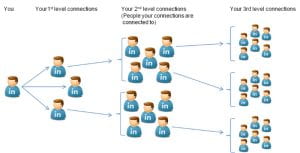LinkedIn: A Real World Example of Strong and Weak Ties and Strong Triadic Closure
LinkedIn’s platform is a complex professional and social network that exemplifies class network theories related to the concepts of strong and weak ties. These connections foster professional development and networking success on the platform, offering advantages to users and exemplifying the ideas of strong triadic closure and the strength in strong and weak ties.
Strong connections on LinkedIn, often close family members, friends, or long-term colleagues, hold significance for several reasons. Firstly, these connections are built on a foundation of trust and mutual support, making them valuable for job recommendations and references. Such endorsements from close contacts carry substantial weight with potential employers. Additionally, strong ties facilitate in-depth exchanges of industry insights and professional advice. This rich knowledge sharing can be instrumental in overcoming career challenges and making well-informed decisions. Although strong ties are advantageous in their ability to provide support in career development, Gradovetter asserts that strong ties do not offer novel information or new opportunities for users in a network. This same theory also applies to LinkedIn.
Weak connections on LinkedIn, which may include friends of friends, acquaintances or professionals met in passing. Weak ties serve as bridges between diverse professional groups, offering access to new information and opportunities that strong ties may not provide, as they often circulate within similar circles. These connections bring fresh perspectives and knowledge from diverse industries or geographical locations, enriching one’s understanding of different business opportunities and engagements. LinkedIn’s structure of showing 1st, 2nd, and 3rd level connections actively promotes the formation of weak ties. Users are more inclined to connect with 2nd and 3rd level connections as they observe their interactions and engagements with mutual connections, enhancing the likelihood of discovering new opportunities and expanding their professional networks. The exposure to 2nd and 3rd level connection content confirms LinkedIn’s correlation with strong triadic closure as shared 1st level connections between two users often lead to the creation of a connection between the two users. The principle of strong triadic closure underscores that strong connections often grant access to otherwise exclusive networks. When two individuals share a mutual strong connection, they are more likely to form a strong tie themselves, thereby expanding each other’s networks.
The interplay between strong and weak ties on LinkedIn is further highlighted by the platform’s design. Users are exposed to the activities of their connections, including likes, comments, and shares. This feature not only reinforces existing ties by keeping users informed about their connections’ professional activities but also encourages the formation of new ties. Witnessing a 1st level connection interact with someone else can lead to a 2nd or 3rd level connection, effectively building a bridge to a new network. Over time, these new connections can evolve, potentially becoming strong ties through continued interaction and shared professional experiences. This platform structure also offers the potential to share novel information and opportunities to 2nd and 3rd connections, allowing for greater exposure to potential job opportunities and industries that may have remained unexplored otherwise.
More so, LinkedIn advances the value of weak ties as users are motivated to create a large network of connections to get to over 500 total connections on the platform. This feature further motivates users to connect with connections of connections, thus propelling the strong triadic closure theory. The more connections one has leads to a greater amount of information accessed as users continue to see content of their connection’s connections while increasing their network.
Thus, LinkedIn serves as a network where the principles of strong and weak ties, as well as strong triadic closure, come to life in real-time. Strong ties offer depth, trust, and knowledge exchange, while weak ties provide breadth, diversity, and access to fresh opportunities. The platform’s ability to showcase various levels of connections (1st, 2nd, and 3rd) and the interactivity among them further solidifies its role as a powerful tool for professional networking and career development. Understanding and leveraging both types of connections can lead to a more robust and dynamic professional network, which is essential for career advancement in today’s highly technological world.

